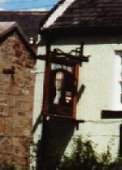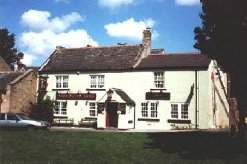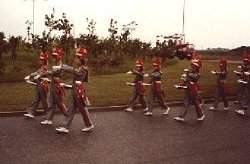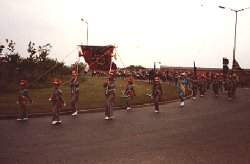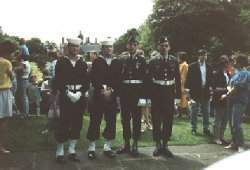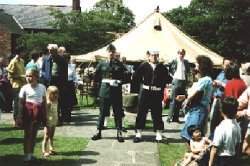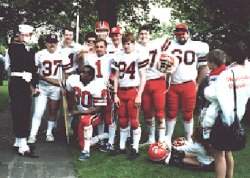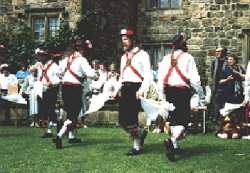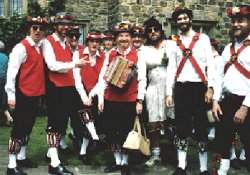The USA Connection
Ancient Egyptians and the Constellations: Part 22
George Washington: The First President of the United States of America
Washington Village, Tyne-Wear, is renowned the world over as the ancestral home of George Washington, the First President of the United States of America. His great-grandfather, Colonel John Washington, emigrated to Virginia in 1656 from Sulgrave Manor in Northamptonshire. The Washington family relocated to Sulgrave Manor from Washington Manor, via Westmoreland, Lancashire and Warwickshire, in the early to mid sixteenth century.


The Washington family name was inherited from the name of the property of which the family assumed ownership in 1183. The Ancestor of George Washington who assumed ownership of the lands of Washington was William de Hertburn. He was a knight whose ancestors fought alongside William the Conqueror. He was not English; he was of Norman descent. Hertburn Gardens is named after him. The Washington lands previously belonged to the Bishop of Durham but he exchanged them for the Hertburn lands in Stockton. This is how William of Hertburn became known as William of Washington.
The first stone manor house on the site of the present Old Hall was probably built shortly after the Battle of Shadon's Hill in 1068 when the people of the North revolted against William the Conqueror. Shadon's Hill stands at the Washington- Springwell entrance to Eighton Banks. My dad's side of the family, the Hall family, lived at Eighton Banks. It is a very old surname and there is a good chance that my ancestors fought against William the Conqueror at the Battle of Shadon's Hill.
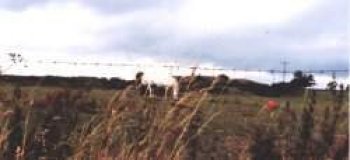
After the Battle of Shadon's Hill it would be logical that William would install one of his fellow countrymen in a nearby locality to quell the natives and prevent further insurrections. Washington Village would have been the ideal location.
Certainly the stone manor house was built in the Norman architectural style. The stone archways between the current kitchen and the Great hall evidence this. The present Washington Old Hall was built in the early 1600's on top of the original Norman foundations.

The Coat of Arms adopted by William de Wassington reflects his position and status of a knight. It comprises three red five-pointed stars and two red banners, in the horizontal position, on a white background. Originally however the background was silver. Heraldry in the form of standards dates back to the Ancient Egyptians as early as 4468BC. (See Part 12) The introduction of heraldry into England is credited to William I after the Norman Conquest of 1066. Originally the shields are believed to have been a single colour but as the custom grew more popular a second colour was introduced. The very early composition of the Washington Coat of Arms is reflected in its use of only two colours.
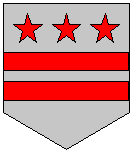
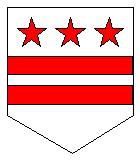
argent, two bar and in
chief three mullets gules.
white, two bar and in
chief three mullets red.
There were certain basic rules which had to be followed in the design of an emblazonment. Metal must not be set upon metal; for example a gold star on a silver background was forbidden. A colour must not be assigned on top of another colour; for example red upon white was forbidden. The metal and the colour must be incorporated into the design. Over the centuries yellow and white replaced the gold and silver.
There is a unique heraldic vocabulary which is used to describe a Coat of Arms. With reference to the Washington crest:
- The background is called "the field".
- The stripes are called "the charges".
- The two stripes in the horizontal position are referred to as a "two bar" design. Forty years ago and more these stripes were referred to locally as "banners".
- The upper section of the shield, or field, is called "the chief".
- The three stars in the chief are "the secondary charges".
A five-pointed star is called "a mollet" or "mullet" because it resembles the rowel of a spur. A rowel is a spiked disk on a spur, used to urge on the horse to victory. It is also a piece of hair or leather with a hole in it which is placed under a horse's skin to discharge pus. The 14th century Coat of Arms of William de Wassington has three pierced mullets. Combining these two meanings the mullet signifies Endurance and Purification, or taken one step further, Endurance to achieve Purification. Having thus distinguished himself the candidate "won his spurs": he was made a knight.
- The white field was originally silver, and is referred to as "argent".
The red of the charges and secondary charges is referred to as "gules", which comes from the Latin meaning "ermine, dyed red". Ermine, the white winter fur of the stoat, signifies Peerage, Judgement and Purity.
In heraldic terms the Washington Coat of Arms was created soon after the Norman Conquest of 1066. This is borne out by the fact that only argent and gules were used in its composition. The field is argent, and the two bar charge is gules. The secondary charge in the chief, comprising three mullets, is also gules.
Expressed in its most precise terms the Washington Coat of Arms is described as: argent, two bar and in chief three mullets gules. The intrinsic meaning is "Endurance to achieve Purification. Winning one's spurs and becoming a knight, a member of the Peerage. As a member of the peerage the knight can sit in Judgement because he himself is considered to be Pure."
The Washington family took great pride in their heritage, such that when they emigrated to America they retained their family crest. As a result, when George Washington, who was a prominent Freemason, became the First President of the United States, it was the Washington Coat of Arms which was adopted as the basis of the American flag. Expressed in everyday language the red banners on the white background were retained, but the red stars on a white background were replaced with white stars on a blue background. The stars and banners of Washington Village became the "Stars and Stripes" of the leading world power!

was based on the Coat of Arms of the George Washington whose
ancestors hailed from Washington Village, Tyne-Wear.
Commemoration of the USA/ Washington Connection
The USA connections with Washington Village are commemorated in many ways. For example:
